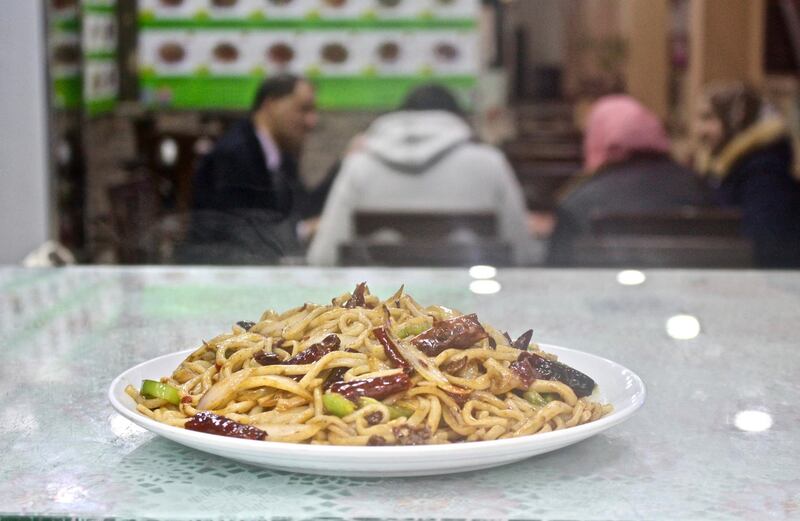It’s early Thursday evening in Amman and Ali Noureldin’s open-air restaurant on the third floor of Majdi Mall by Jordan University is bustling. It’s a diverse crowd, with everyone from students to office workers, all gathering to dine in the low-key, self-service eatery.
The Islamic Chinese Restaurant, is, after all, the only place around offering the authentic food of the Hui – Chinese Muslim community – including those luscious, long laghman hand-pulled noodles the cuisine is famous for. As Noureldin, 35, puts it: he serves up the "shaabi", the popular halal Chinese equivalent of mansaf, maqlouba, hummus and falafel – all those Jordanian homestyle favourites found just about anywhere here.
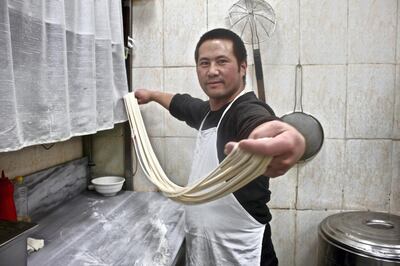
"It's Islamic food," Noureldin tells The National. "Everyone loves it."
Setting up shop
Noureldin is from Xining, the capital of Qinghai province, in western China. It's home to many Hui Chinese people, and where Noureldin and his wife lived, before he moved to Jordan in 2010. The Hui people are not to be confused with Uyghurs, another population of Chinese Muslims based in nearby Xinjiang province, but the two communities share similar cuisines.
It was a master's degree in Arabic that originally took the father-of-three to Amman, but he liked the city so much that he stayed to open his shop in 2014. He noticed a gap in the hospitality market, as students like him were craving a taste of home. It was an important move, he says, as it meant he could introduce the local community to China's rich and diverse cuisine rooted in Islamic culinary traditions.
An authentic taste of China
All of his spices are imported from his homeland, and the menu – made up of numbered pictures in a book and splashed across the walls of the mall – is extensive.
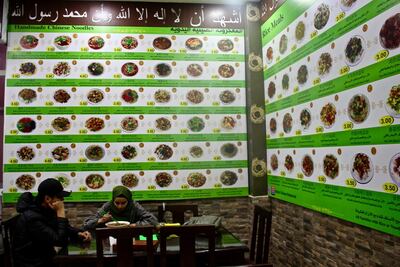
In particular, Xining is renowned for its mouthwatering Hui street-food scene, which is especially heavy on the halal meat and peppery spices such as cumin. It's most famous for those laghman, also called lamian, hand-pulled noodles, the making of which stems from a culinary art honed over thousands of years. For the last year, Eisa Ma, 28, also from the Qinghai province, has been kneading and stretching simple white dough into freshly simmering noodles.
"Not every person can make laghman," Noureldin says. When an order comes, Ma pulls out a chunk of dough, tops it with a little brine and oil and kneads it over and over again as he works to create the right elasticity. In a rhythm of his own, he tenderly twirls and beats the dough, repeating this dance for a few minutes until he's satisfied with how stretchy it is.
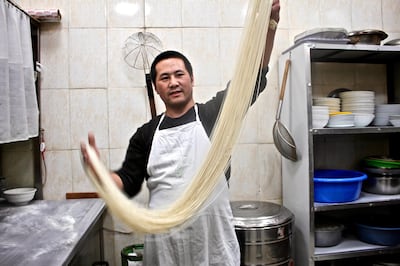
Then the real fun begins: Ma pulls the softened dough into thinner and thinner rounds as it expands into one wonderfully long noodle, which he expertly wraps around his fingers. With a final flourish, he cuts one end free and drops them into a vat of boiling water. They take just a few minutes to cook.
The noodles are served in all kinds of combinations, with a variety of different sauces. There's sautéed vegetables with slices of tender meat (one of Noureldin's favourites), more meat with chilli peppers in the Sichuan tradition, Uyghur-style with fried meat spiced with cumin and onions, Guangzhou-style with shrimps and vegetables, and vegetarian-friendly takes with tomatoes and fried eggs. Among the Hui community, the noodles are especially beloved simmering in beef broth, perhaps mixed with some more tender beef slices and signature chilli oil.
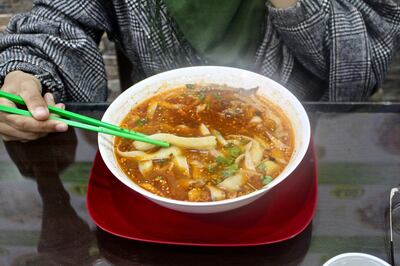
Although Hui cuisine can be heavy on the meat, there are also delicious vegetarian dishes, like richly flavoured black mushrooms and spicy fried cabbage with chilli pepper. Noureldin's favourite dishes on his menu are the shish barak dumplings, served in soup or on their own, and cumin-flavoured dapanji – a big plate of chicken. He sometimes eats this twice a day.
Something for everyone
The Islamic Chinese Restaurant also serves a range of rice dishes with a spread of traditional Chinese cooking styles that take influence from across the country.
For eaters hesitant to try new foods, Noureldin's thought of that, too – he has less-adventurous fare, such as chopped hot dogs with vegetables.
There are, however, some very labour-intensive Hui dishes you won't find on the menu, like tender slices of mutton cooked for hours in spices and lamb broth, or liangpi starch-based noodles, the beloved street-food lamb kebabs and Uyghur nang (or naan) – sesame-topped bread.
Nonetheless, Noureldin is filling a gap in the market. In 2015, he opened another branch in Irbid at Yarmouk University, where there are also many Chinese and Asian-Muslim students. Now he has his sights set on opening a branch in Oman, where a friend of his lives, and, eventually, in America, where he's heard Muslim Chinese food isn't very well known.
For now, this hole-in-the-wall is feeding a niche in Amman's foodie market, which caters to an increasingly diverse population. Among the Filipino restaurants, Indian eateries and Levantine cafes, Noureldin is making sure his fellow Asian-Muslims are well-fed.
“People love the food,” he says, proudly. And that’s all that matters.
